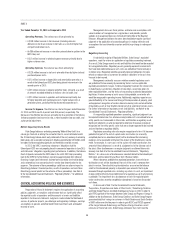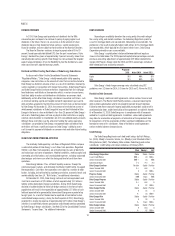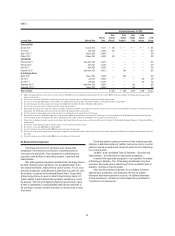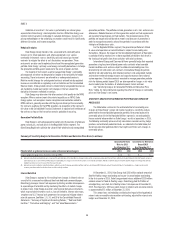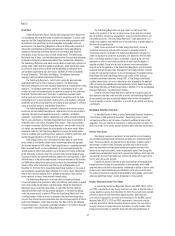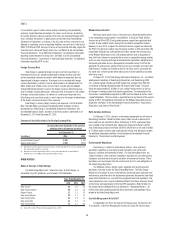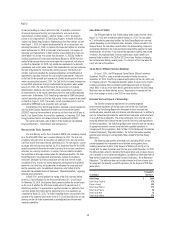Duke Energy 2014 Annual Report Download - page 76
Download and view the complete annual report
Please find page 76 of the 2014 Duke Energy annual report below. You can navigate through the pages in the report by either clicking on the pages listed below, or by using the keyword search tool below to find specific information within the annual report.
56
PART II
Validation of a contract’s fair value is performed by an internal group
separate from Duke Energy’s deal origination function. While Duke Energy uses
common industry practices to develop its valuation techniques, changes in its
pricing methodologies or the underlying assumptions could result in signifi cantly
different fair values and income recognition.
Hedging Strategies
Duke Energy closely monitors risks associated with commodity price
changes on its future operations and, where appropriate, uses various
commodity instruments such as electricity, coal and natural gas forward
contracts to mitigate the effect of such fl uctuations on operations. These
instruments are also used to optimize the value of the nonregulated generation
portfolio. Duke Energy’s primary use of energy commodity derivatives is to hedge
the generation portfolio against exposure to the prices of power and fuel.
The majority of instruments used to manage Duke Energy’s commodity
price exposure are either not designated as hedges or do not qualify for hedge
accounting. These instruments are referred to as undesignated contracts.
Mark-to-market changes for undesignated contracts entered into by regulated
businesses are refl ected as regulatory assets or liabilities on the Consolidated
Balance Sheets. Undesignated contracts entered into by unregulated businesses
are marked-to-market each period, with changes in the fair value of the
derivative instruments refl ected in earnings.
Duke Energy may also enter into other contracts that qualify for the NPNS
exception. When a contract meets the criteria to qualify as an NPNS, Duke
Energy applies such exception. Income recognition and realization related to
NPNS contracts generally coincide with the physical delivery of the commodity.
For contracts qualifying for the NPNS exception, no recognition of the contract’s
fair value in the Consolidated Financial Statements is required until settlement of
the contract as long as the transaction remains probable of occurring.
Generation Portfolio Risks
Duke Energy is primarily exposed to market price fl uctuations of wholesale
power, natural gas, and coal prices in the Regulated Utilities segment. The
Duke Energy Registrants optimize the value of their wholesale and nonregulated
generation portfolios. The portfolios include generation assets, fuel, and emission
allowances. Modeled forecasts of future generation output and fuel requirements
are based on forward power and fuel markets. The component pieces of the
portfolio are bought and sold based on models and forecasts of generation in
order to manage the economic value of the portfolio in accordance with the
strategies of the business units.
For the Regulated Utilities segment, the generation portfolio not utilized
to serve retail operations or committed load is subject to commodity price
fl uctuations. However, the impact on the Consolidated Statements of Operations
is partially offset by mechanisms in these regulated jurisdictions that result in
the sharing of net profi ts from these activities with retail customers.
International Energy and Commercial Power generally hedge their expected
generation using long-term bilateral power sales contracts when favorable
market conditions exist and are subject to wholesale commodity price risks
for electricity not sold under such contracts. International Energy dispatches
electricity not sold under long-term bilateral contracts into unregulated markets
and receives wholesale energy margins and capacity revenues from national
system operators. Derivative contracts executed to manage generation portfolio
risks for delivery periods beyond 2015 are also exposed to changes in fair value
due to market price fl uctuations of wholesale power, fuel oil and coal.
See “Sensitivity Analysis for Generation Portfolio and Derivative Price
Risks” below, for more information regarding the effect of changes in commodity
prices on Duke Energy’s net income.
SENSITIVITY ANALYSIS FOR GENERATION PORTFOLIO AND DERIVATIVE
PRICE RISKS
The table below summarizes the estimated effect of commodity price
changes on Duke Energy’s pretax net income, based on a sensitivity analysis
performed for the nonregulated generation portfolio. Forecasted exposure to
commodity price risk for the Regulated Utilities segment is not anticipated to
have a material adverse effect on Duke Energy’s results of operations in 2015.
The following commodity price sensitivity calculations consider existing hedge
positions and estimated production levels, as indicated in the table below, but
do not consider other potential effects that might result from such changes in
commodity prices.
Summary of Sensitivity Analysis for Generation Portfolio and Derivative Price Risks (in millions)
Generation Portfolio
Risks for 2015
As of December 31,(a)
Sensitivities for Derivatives
Beyond 2015
As of December 31,(b)
Potential effect on pretax net income assuming a 10 percent price change in 2014 2013 2014 2013
Forward wholesale power prices (based on price per MWh) $4 $1 $— $—
(a) Amounts related to forward wholesale prices represent the potential impact of commodity price changes on forecasted economic generation which has not been contracted or hedged. Amounts related to forward coal prices
and forward gas prices represent the potential impact of commodity price changes on fuel needed to achieve such economic generation. Amounts exclude the impact of mark-to-market changes on undesignated contracts
relating to periods in excess of one year from the respective date.
(b) Amounts represent sensitivities related to derivative contracts executed to manage generation portfolio risks for periods beyond 2014. Amounts exclude the potential impact of commodity price changes on forecasted
economic generation and fuel needed to achieve such forecasted generation.
Interest Rate Risk
Duke Energy is exposed to risk resulting from changes in interest rates as
a result of its issuance of variable and fi xed-rate debt and commercial paper.
Duke Energy manages interest rate exposure by limiting variable-rate exposures
to a percentage of total debt and by monitoring the effects of market changes
in interest rates. Duke Energy also enters into fi nancial derivative instruments,
which may include instruments such as, but not limited to, interest rate swaps,
swaptions and U.S. Treasury lock agreements to manage and mitigate interest
rate risk exposure. See Notes 1, 6, 14, and 16 to the Consolidated Financial
Statements, “Summary of Signifi cant Accounting Policies,” “Debt and Credit
Facilities,” “Derivatives and Hedging,” and “Fair Value Measurements.”
At December 31, 2014, Duke Energy had $250 million notional amount of
fi xed-to-fl oating swaps outstanding and no pre-issuance hedges outstanding.
In the fi rst quarter of 2015, Duke Energy entered into an additional $250 million
notional amount of fi xed-to-fl oating swaps. Duke Energy had $6.9 billion of
unhedged long- and short-term fl oating interest rate exposure at December 31,
2014. The impact of a 100 basis point change in interest rates on pretax income
is approximately $72 million at December 31, 2014.
This amount was estimated by considering the impact of the hypothetical
interest rates on variable-rate securities outstanding, adjusted for interest rate
hedges as of December 31, 2014.


